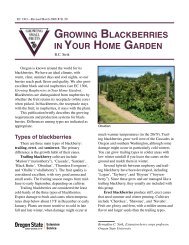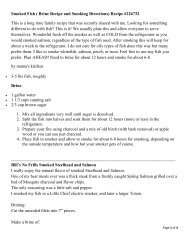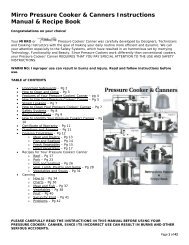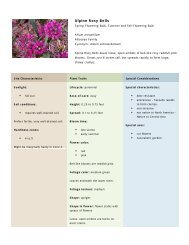Create successful ePaper yourself
Turn your PDF publications into a flip-book with our unique Google optimized e-Paper software.
It's a good idea to check your soil acidity. Plants can't absorb the nutrients they need if the<br />
soil does not have the proper pH level. While most plants prefer a neutral soil (pH 6.5-7.0),<br />
plants such as azaleas and blueberries require an acidic soil (pH 5.5-6.0). You can test your<br />
soil's pH yourself, using a kit sold at your local garden center. Or, contact your county or<br />
state agriculture extension service. Instead of testing it yourself, you may send soil samples<br />
to either of these outlets to test soil pH and nutrients for you.<br />
FERTILIZING-The plants you obtain from <strong>Michigan</strong> <strong>Bulb</strong> are guaranteed to grow<br />
without the addition of plant food, but enriching your plant site with selected nutrients<br />
such as those found in Wonder X" Plant Food or Power Pills will encourage fuller growth<br />
and more profuse blooming. (See back cover.)<br />
- -<br />
HARDY BULBS<br />
This section also includes TUBERS, CORMS,<br />
RHIZOMES AND TUBEROUS ROOTS.<br />
'-- ..1-_-'-__ -' Spring-flowering bulbs, such as tulips and daffodils, can be<br />
interplanted among perennials to provide the garden with<br />
color in spring-a time when most perennial borders are short on color. Store bulbs in a<br />
cool, dry place until ready to plant. When planting, dig generously sized holes.<br />
Please refer to the planting depths shown on the bulb bag. As a general rule, bulbs should<br />
be planted at a depth that is two to three times the height of the bulb. Position your bulbs<br />
in the hole and cover with loose soil. Most bulbs should be planted with the pointed end<br />
up, unless indicated otherwise on the label attached to the bulb package.<br />
If you are planting a large quantity of bulbs, you may want to speed up the process. Dig a<br />
large planting area to the appropriate bulb depth. Position each bulb in this planting area;<br />
cover with loose soil and water thoroughly.<br />
<strong>Bulb</strong>s that stay underground year-round should be protected by mulch in winter. Summer<br />
mulching to conserve moisture is a good idea, too. After blooming season is over, do not<br />
cut back the leaves. Let the foliage yellow and die down naturally. The leaves provide<br />
nourishment to the bulb to produce next year's blooms.<br />
PINK DAFFODILS=-When pink daffodils first unfold, the trumpet is a lovely yellowapricot<br />
color which will gradually change to a soft pink. It is important to plant this<br />
variety in a full sun area, as full sunlight will turn the trumpet a deeper pink.<br />
- - - - - - -<br />
TENDER BULBS<br />
Summer-flowering bulbs such as dahlias, begonias, gladiolus, cannas and calla lilies are<br />
less hardy in colder climates and should be lifted each fall. You may lift your bulbs prior<br />
to a killing frost or as soon as the frost has blackened the foliage. Dig up the bulbs gently,<br />
being careful not to cut or damage them. Store them in a well-ventilated, frost-free area<br />
until the foliage has dried up. Remove the foliage and place your bulbs in an unsealed<br />
paper bag, old nylon stocking or a shallow, plastic-lined box with a blanket of peat moss<br />
or vermiculite.<br />
Summer-flowering bulbs require winter storage temperatures between 35-45°F. An ideal<br />
storage location would be the vegetable compartment of a refrigerator, an unheated garage<br />
or cellar-type basement. Most modem basements aren't cool enough for winter bulb storage.<br />
PAGE 3












